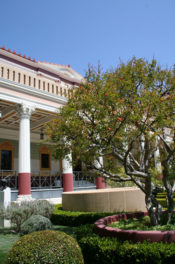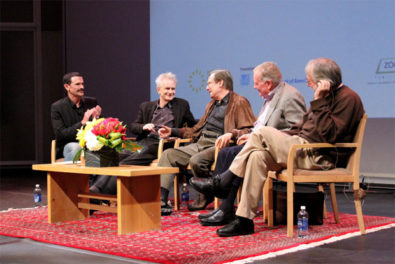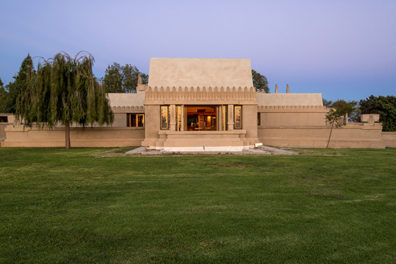An angel looks down on L.A. neighborhoods for the exhibition Heaven and Earth. He’s perfectly at home in the Byzantine-Latino Quarter, historic center of L.A.’s Greek Orthodox community

You may have seen him by now. Flying conspicuously around Los Angeles neighborhoods, the Archangel Michael holds a transparent orb in his left hand and reminds us, the passersby, that Byzantium is part of this hybridized melting pot of a city.
 The banners that publicize the Heaven and Earth exhibition at the Getty Villa have created an interesting and at times ironic juxtaposition between our newfangled metropolis and the aura of a Byzantine icon.
The banners that publicize the Heaven and Earth exhibition at the Getty Villa have created an interesting and at times ironic juxtaposition between our newfangled metropolis and the aura of a Byzantine icon.
One of the most striking locations of these banners is Normandie Avenue between Pico and Venice Boulevards. The noteworthiness of this particular location is not simply the anomaly of the Archangel Michael icon flying amidst signs of our current consumer culture, but rather his significance within this historic neighborhood. You can sense the dialogue between the icon of the Archangel and the buildings that surround it. The image speaks to Saint Sophia Cathedral beside it and the little Greek restaurant, Papa Cristo’s, behind it, and it flies alongside the embracing angels across the street. Simply put, the banner belongs here, deep in the Byzantine-Latino Quarter.


The Original “Greek Town”
“We are each of us angels with one wing. We can only fly embracing each other.”
So reads the mural across the street from the Saint Sophia Cathedral in the Pico-Union neighborhood of Los Angeles, marking the center and essence of the Byzantine-Latino Quarter. Nestled within a time-honored L.A. neighborhood among modest storefronts and craftsman bungalows, the Greek Orthodox cathedral remains a towering vestige of what was once known simply as “Greek town.”
I had the pleasure of sitting down and speaking with the Very Reverend John Bakas, the current Dean of Saint Sophia. Father John is a charismatic church leader with an impressive résumé of charitable work in the city, who has also been a leader in the revival of the Byzantine-Latino quarter.

Father John Bakas
The Byzantine-Latino Quarter is centered along Pico Boulevard between South Hobart Boulevard and South Alvarado Boulevard. In the mid-20th century there was a significant Greek population concentrated in this area, and with it came an influx of Greek goods and culture. In 1952, Charles Skouras, the head of Fox West Coast, built Saint Sophia Cathedral, which soon became the pillar of Los Angeles’s Greek Orthodox community.

Saint Sophia Cathedral, anchor of Los Angeles’s Greek Orthodox community and the Byzantine-Latino Quarter
When Fr. John arrived at Saint Sophia in 1995, however, he witnessed a steadily declining neighborhood. The crime rate was at its highest and, he says, “people were afraid to have their mothers come here for an evening service. Papa Cristo’s closed every day at five. It was a very difficult time—we could not afford to be a Greek Orthodox ghetto.”
Revival of a Community
Fr. John and a group of determined community members reached out to neighbors and local businesses and devised a plan known as Genesis PLUS, meaning “the birth and more.” With the growing Latin population in mind, the coalition made the choice to name the area the Byzantine-Latino Quarter. “Historically, you have the Latin Church and you have the Byzantine Church,” Fr. John told me. “But you cannot exist in this multilingual, multiethnic, multireligious society by being an isolated little castle. We don’t dilute the faith or the doctrines of the church to be all-inclusive. However, the church is open to all those who want to inquire. We’ve reached out.”
So has this little neighborhood once known only as “Greek Town” come to embody something so much more—a multitude of people, ethnicities, and religions that coexist as a community now known as the Byzantine-Latino Quarter.
While the Byzantine-Latino Quarter is no longer referred to as “Greek Town,” the Hellenic past is still very much present. Yearly, Saint Sophia sponsors the LA Greek Fest on the Cathedral’s grounds, drawing upwards of 15,000 visitors. The festival boasts homemade Greek food and traditional music and dancing, all culminating in an exhilarating celebration of faith and culture.
At the center of the 2013 Greek Fest was the Archangel Michael, a copy of the Byzantine icon printed on the banners. With the support of the Getty Museum and the help of the artist Peter Tigler, the Archangel’s image took the form of a massive paint-by-number project that engaged both adults and children, who used their fingers to transform the icon into an over-life-size artwork. Each of the painters signed the work on the margins, creating a lasting bond between the hands of the painters and the image of the saint.
![]()
Los Angeles is home to many cultures and faiths that enrich our city. For the duration of Heaven and Earth, an archangel flies over our diverse neighborhoods, looks over the streets through which we drive, and reminds us that no matter our differences, we all live in the City of Angels.
Text of this post © Sarah Quaresma. All rights reserved.




Well written, informative, and enjoyable. Wonderful article about an often overlooked part of the LA culture. Thank you, Sarah, for the informative blog about LA’s own Saint Michael and the Getty’s exhibit.
This is such a great post! I love the Byzantine-Latino Quarter and it’s fantastic to see it get some attention for its perseverance over the years. Very well written, Sarah! Thank you.
I was undecided about going to the exhibit … till I read Sarah’s article. Engaging, intriguing. Fascination with the transcendent and the mystical endure in the midst of our (yawn) secularized culture. Byzantium is irrelevant as a world power, but not as a spiritual influence. We need to look up and notice the angels.
Excellent article, the attention brought to Byzantine-Latino quarter really showcases the multicultural are we live in. The contrast between the Byzantine historical roots in the exhibit and the modern-day Byzantine-Latino quarter gives a great perspective into our history. Great Job!!